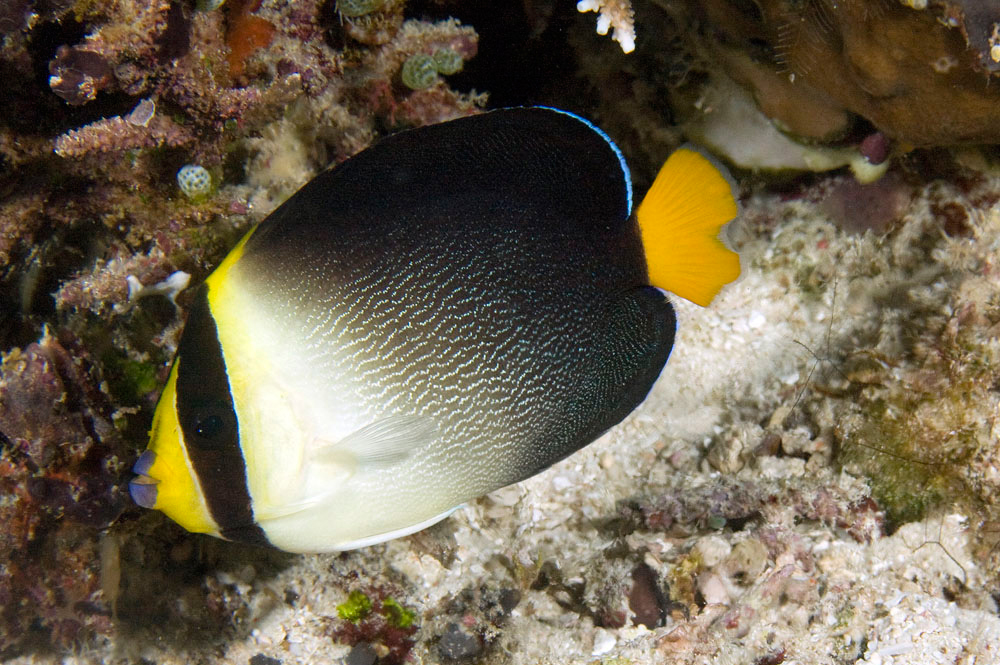Vermiculate Angelfish, Chaetodontoplus mesoleucus (Bloch 1787)
Other Names: Singapore Angel, Vermiculated Angelfish

A Vermiculate Angelfish, Chaetodontoplus mesoleucus, at Raja Ampat, West Papua, Indonesia. Source: Paddy Ryan / http://www.ryanphotographic.com/. License: All rights reserved
Summary:
An angelfish with a yellow snout, blue lips, a broad black band through the eye followed by a whitish area that becomes purplish-grey with pale vermiculations posteriorly, white pelvic fins, and a yellow tail.
Cite this page as:
Bray, D.J. 2020, Chaetodontoplus mesoleucus in Fishes of Australia, accessed 04 Jul 2025, https://fishesofaustralia.net.au/home/species/647
Vermiculate Angelfish, Chaetodontoplus mesoleucus (Bloch 1787)
More Info
|
Distribution |
Reefs of the Kimberley, northwestern Australia, and possibly south to Varanus Island near Barrow Island, and Ashmore Reef in the Timor Sea. Elsewhere the species occurs in the tropical, eastern Indian Ocean and western Pacific - Indonesia, Western Australia to Malaysia, the Philippines and southern Japan. Inhabits inner reefs and lagoons, often in silty areas with rich coral growth, sheltering among hard coral when threatened. |
|
Features |
Dorsal-fin rays 16-18; Anal-fin rays 16-18; Pectoral fin 15-16. |
|
Feeding |
Feeds on sponges, tunicates and algae. |
|
Biology |
Species of the genus Chaetodontoplus are protogynous hermaphrodites: they can change sex from female to male during their life cycle. Males guard a territory containing one or two females. |
|
Similar Species |
The similar Chaetodontoplus poliourus differs in having a grey caudal fin with a narrow yellow margin (vs. a yellow caudal fin in C. mesoleucus), yellow pelvic fins (vs. white pelvic fins in C. mesoleucus), and more pale yellow anteriorly on the dorsal fin. It is known from New Britain (type locality), other localities in Papua New Guinea, Solomon Islands, Palau, and islands of Indonesia. Although the two species coexist at several islands of Indonesia, only C. mesoleucus ranges northwest to the coast of southeast Asia, the Philippines and the Ryukyu Islands, and only C. poliourus is found east of the Indonesian province of West Papua. C. poliourus does not occur in the Australian EEZ. |
|
Etymology |
The specific name mesoleucus is from the Greek mesos (= middle) and leucos (= white), possibly in reference to the white anterior part of the body grading into the black posterior part. |
|
Species Citation |
Chaetodon mesoleucus Bloch 1787, Naturgeschichte der ausländischen Fische Vol. 3: 117, pl. 216, fig. 2. Type locality: Japan (possibly in error). |
|
Author |
Bray, D.J. 2020 |
|
Resources |
Vermiculate Angelfish, Chaetodontoplus mesoleucus (Bloch 1787)
References
Allen, G.R. 1980. Butterfly and angelfishes of the world. Wiley, New York.
Allen, G.R. 1996. New records of reef and shore fishes from northwestern Australia. Records of the Western Australian Museum 18: 109-112
Allen, G.R. 1997. Marine Fishes of Tropical Australia and South-east Asia. Perth : Western Australian Museum 292 pp. 106 pls.
Allen, G.R. & Erdmann, M.V. 2012. Reef fishes of the East Indies. Perth : Tropical Reef Research 3 vols, 1260 pp.
Allen, G.R., Steene, R. & Allen, M. 1998. A Guide to Angelfishes & Butterflyfishes. Cairns : Odyssey Publishing/Tropical Reef Research 250 pp. figs. (both Chaetodontoplus mesoleucus and C. poliourus figured)
Bloch, M.E. 1787. Naturgeschichte der ausländischen Fische. Berlin : J. Morino Vol. 3 146 pp. pls 181-216.
Endoh, K. 2007. Angelfishes of the World. Two Little Fishies, Inc., Miami Gardens, Florida.
Hutchins, J.B. 2001. Biodiversity of shallow reef fish assemblages in Western Australia using a rapid censusing technique. Records of the Western Australian Museum 20: 247-270
Kuiter, R.H. 1992. Tropical Reef-Fishes of the Western Pacific, Indonesia and Adjacent Waters. Jakarta : PT Gramedia Pustaka Utama 314 pp. pls.
Kuiter, R.H., Debelius, H. & Tanaka, H. 2003. Pomacanthidae, a Comprehensive Guide to Angelfishes. Melbourne : Zoonetics 206 pp.
Moyer, J.T. 1990. Social and reproductive behavior of Chaetodontoplus mesoleucus (Pomacanthidae) at Bantayan Island, Philippines. Japanese Journal of Ichthyology 36(4): 459–67. https://doi.org/10.11369/jji1950.36.459
Pyle, R. 2001. Pomacanthidae: Angelfishes. In: K.E. Carpenter and V.H. Niem (eds), FAO species identification guide for fishery purposes. The living marine resources of the Western Central Pacific. Bony fishes part 3 (Menidae to Pomacentridae), pp. 3266-3286. FAO, Rome, Italy.
Randall, J.E. & Rocha, L.A. 2009. Chaetodontoplus poliourus, a new angelfish (Perciformes: Pomacanthidae) from the tropical western Pacific. The Raffles Bulletin of Zoology 57(2): 511-520. See ref online










